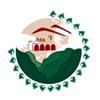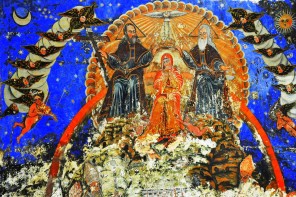| The Monastery of Saint Anthony the Great (Mar Antonios al-Kabir) is situated at a height of 950 meters above sea level in the celebrated Valley of Qozhayya in the region of the valley of saints ” the Living Treasure “, in the Zghorta district of North Lebanon. |
| The pine trees and oak trees cover the great hills surrounding it. Fruit trees of every description grow all along the valley which extends into the Valley of Qannubin to form the great Qadisha Valley, thus bearing witness to the history of eremitic life and the quest for holiness in Lebanon. |
| Historians and scholars suppose that this Monastery was first built and began to be occupied by hermits at the beginning of the fourth century. It was several times looted, set on fire and razed to the ground, but there still remain vestiges dating back to the seventh century. Monastery constituted the first Maronite episcopal see. |
| The Monastery has always been the stronghold of eremitical life within the Maronite Church as well as a school for the formation of monks. Its hermitages, in particular that of Saint Bishai, have always attracted ascetics wishing to live a life of mortification away from the world. |
| Among these austere hermits, one can cite: patriarchs Moses (Moussa) al-Akkari (1524-1567), Michael (Mikhayel) ar-Rezzi (1567-1581), Sergius (Sarkis) ar-Rezzi (1581-1596), and Joseph (Yusuf) ar-Rezzi (1596-1608). |
| The Monastery became the pillar and reference-point of the Order until it was even called ” the Order of Qozhayya “. The monks suffered persecution from oppressors who several times drove them out of the Monastery, beat them, and threw them into prison. Pressure was even exerted on them by certain religious authorities. |
| In 1994 the great underground basement was restored and now serves as a museum in which are gathered what remains of the printing press of 1783 and various manuscripts, liturgical objects, ancient pottery, and a crozier offered by Louis IX, King of France (1226-1270). The museum was inaugurated on November 10, 1994, on the occasion of the opening of the celebration of the tricentenary of the Order, by Patriarch Mar Nasrallah Butrus Sfeir (1986 ), with the attendance of the Apostolic Nuncio, the Maronite bishops, and the Superior Generals, Mother Generals and monks of the two Orders, Mariamite and Lebanese. |
| In December 1998, the Monastery Saint Anthony of Qozhayya, all the valley of Qadisha and the Cedars of Lebanon were classified by the UNESCO as worldwide cultural heritage. It must be mentioned here that the Monastery of Qozhayya possesses a library containing archives, scholarly compendia and Syriac manuscripts. As in its early days, it is still a center of pilgrimage and prayer for those in search of a place suitable for prayer, recollection and solitude, and those wanting cures or advice. |
| Pilgrims also come to consult the hermits Father Anthony (Antonios) Shina, who entered the hermitage dedicated to Saint Paul of Thebes (Mar Boula), first hermit of the Egyptian desert, on May 30,1982, and is still there; and Father Dario Escobar, from Colombia, who is living in the Hermitage of Our Lady of Hawqa since August 15th, 2000. |
| The Monastery remains a beacon of salvation and holiness; this is the fact that imparts to it all its charisma and fascination! ( Monastery of Kozhayya- The history of the monastery of Kozhayya – from the official site of Kozhayya) |
Mar Antonios Qozhaya
Tags from the story
St Antonios Qozhaya



